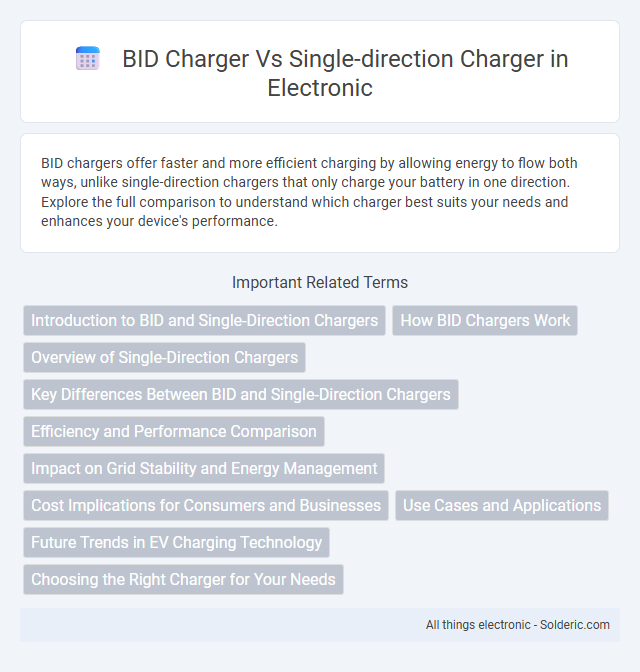BID chargers offer faster and more efficient charging by allowing energy to flow both ways, unlike single-direction chargers that only charge your battery in one direction. Explore the full comparison to understand which charger best suits your needs and enhances your device's performance.
Comparison Table
| Feature | BID Charger | Single-direction Charger |
|---|---|---|
| Charging Direction | Bidirectional (charge and discharge) | Unidirectional (charge only) |
| Energy Flow | Two-way energy flow (grid to device and device to grid) | One-way energy flow (grid to device) |
| Application | Vehicle-to-grid (V2G), energy storage systems, backup power | Standard electric vehicle or device charging |
| Cost | Higher initial cost due to complex technology | Lower cost with simpler design |
| Energy Efficiency | May have slightly lower efficiency due to bidirectional circuitry | Typically higher efficiency for charging only |
| Grid Interaction | Supports grid services like load balancing and energy backfeed | No grid interaction beyond charging |
| Installation Complexity | More complex installation and management | Simple installation and operation |
Introduction to BID and Single-Direction Chargers
BID chargers enable bi-directional energy flow, allowing your electric vehicle to both charge from and supply power back to the grid, enhancing energy flexibility and supporting grid stability. Single-direction chargers, however, only allow energy to flow one way--from the grid to the vehicle--primarily focusing on straightforward charging without energy return capabilities. Understanding these differences helps you optimize energy management and leverage advanced charging infrastructure for your needs.
How BID Chargers Work
BID chargers enable bidirectional energy flow, allowing your electric vehicle to not only draw power for charging but also supply electricity back to the grid or home. These chargers utilize advanced power electronics to convert DC power from the vehicle battery to AC power for external use, supporting vehicle-to-grid (V2G) and vehicle-to-home (V2H) applications. This two-way charging capability enhances energy flexibility and contributes to grid stabilization while maximizing the utility of your EV battery.
Overview of Single-Direction Chargers
Single-direction chargers efficiently convert electrical energy by allowing current to flow in only one direction, commonly used in traditional electronics and battery charging systems. These chargers offer simplified design and reliable performance, particularly suitable for applications with fixed input and output configurations. When choosing your charging solution, single-direction chargers provide stable voltage regulation and cost-effective operation for straightforward power management needs.
Key Differences Between BID and Single-Direction Chargers
BID chargers offer bidirectional power flow, enabling both charging and discharging of your electric vehicle or energy storage system, while single-direction chargers only allow power to flow in one direction--from the grid to the battery. This key difference makes BID chargers ideal for vehicle-to-grid (V2G) applications, energy management, and backup power solutions. Understanding these distinctions helps optimize your energy efficiency and leverage advanced features not available with single-direction chargers.
Efficiency and Performance Comparison
BID chargers utilize bidirectional charging technology that enables both charging and discharging, improving energy efficiency by allowing power flow to and from devices or vehicles, which reduces energy waste during transfer. Single-direction chargers operate solely in one mode--charging--resulting in less versatile energy management and potentially lower overall efficiency in systems requiring energy feedback. Your choice of BID charger enhances performance in applications demanding energy autonomy and grid interaction, while single-direction chargers suffice for straightforward power delivery scenarios.
Impact on Grid Stability and Energy Management
Bidirectional chargers enhance grid stability by enabling vehicle-to-grid (V2G) energy flow, allowing electric vehicles to discharge electricity back to the grid during peak demand, thus reducing grid stress and balancing supply. Single-direction chargers only draw power from the grid to charge vehicles, limiting their role in energy management and grid support. Integrating bidirectional charging systems facilitates demand response programs and renewable energy integration, improving overall grid resilience and efficiency.
Cost Implications for Consumers and Businesses
Bidirectional chargers typically involve higher upfront costs compared to single-direction chargers due to their advanced technology and capability to both charge and discharge energy. However, businesses and consumers can benefit from potential savings through energy arbitrage, load balancing, and participation in demand response programs, which single-direction chargers cannot provide. Your investment in bidirectional charging may result in lower operational costs and increased energy efficiency over time, offsetting the initial expense.
Use Cases and Applications
Bidirectional chargers enable electric vehicles to not only draw energy from the grid but also supply power back, supporting vehicle-to-grid (V2G) applications and enhancing energy management in smart homes and commercial settings. They are ideal for demand response programs, emergency power supply, and renewable energy integration, making them valuable in both residential and utility-scale scenarios. Single-direction chargers primarily focus on efficient, fast energy transfer from the grid to the vehicle, suited for routine daily charging in personal and public infrastructure without energy feedback capabilities.
Future Trends in EV Charging Technology
Bidirectional chargers enable electric vehicles to not only charge but also discharge energy back to the grid, supporting vehicle-to-grid (V2G) applications that enhance grid stability and energy efficiency. Future trends emphasize the integration of smart bidirectional charging systems with renewable energy sources, enabling dynamic energy management and demand response capabilities. Advances in power electronics and communication protocols are accelerating the adoption of bidirectional chargers as key components for sustainable, resilient EV charging infrastructure.
Choosing the Right Charger for Your Needs
A BID charger supports bidirectional charging, enabling both charging your device and supplying power back to the grid or other devices, ideal for electric vehicles with vehicle-to-home (V2H) or vehicle-to-grid (V2G) capabilities. Single-direction chargers only allow one-way power flow from the grid to the vehicle, making them simpler and often more cost-effective for basic charging needs. Selecting between these chargers depends on your energy usage patterns, the potential for energy cost savings, and compatibility with smart energy systems.
BID charger vs Single-direction charger Infographic

 solderic.com
solderic.com